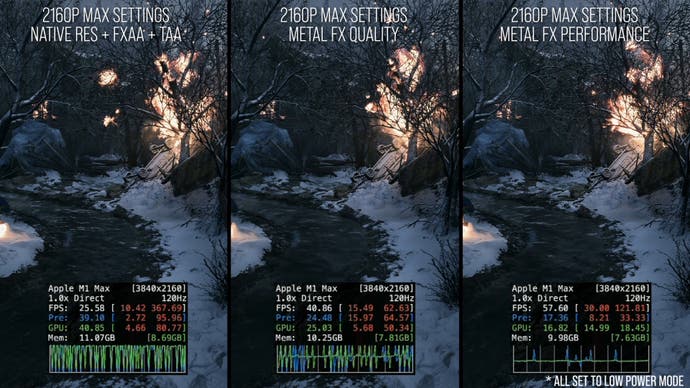Resident Evil Village on Apple Silicon: MetalFX upscaling is a welcome surprise
The port could be better - but a DLSS rival for Mac is big news.
Most Mac game ports are pretty simple: take an existing Windows title, run it through a compatibility layer like Wine, make some UI tweaks and you're most of the way to a half-decent Mac version. This approach often leads to performance and stability issues, but it's a reasonably easy way to convert a popular game to MacOS. However, with the advent of Apple Silicon - Apple's custom ARM-based Mac SoCs - we're starting to see a different approach. A handful of popular games have been released or are planned for release for Macs with Apple Silicon, and these are full-blown native versions that use Apple's high-performance Metal graphics API. This is good news, but more interesting still is that the MetalFX upscaling technology showcased in Resident Evil Village is genuinely good - indeed, it looks like a proper DLSS/FSR2 competitor.
Resident Evil Village seems like a pretty unassuming Mac port at first glance. It looks like a feature-complete port of the existing game with little to distinguish it from the existing console and PC versions, but there is something curious nestled away in the settings menu: an option for MetalFX Upscaling with selections for quality and performance. Apple's initial MetalFX demo videos from June didn't exactly impress, showing remarkably simple content that lacks much in the way of perceptible detail increases in its scaling. However, the reality in this shipping game is somewhat different - it's very impressive.
MetalFX Quality at 4K compared against native 4K in a challenging scene shows a similar level of detail, despite upscaling from an internal 1080p resolution.This makes it a second generation upscaler very much comparable to DLSS, FSR2 and Epic's TAAU Gen 5. Unfortunately, Capcom's TAA implementation on RE8 on PC and on Mac is broken and basically doesn't work so some of the improvement in head-to-head comparisons is down to the use of the properly functioning TAA delivered by MetalFX Quality. Still, this is impressive stuff and even at 1080p, upscaling from 960x540, we're getting some good results - great for lower-end Apple Silicon.
So what's the catch? MetalFX Quality tends to struggle somewhat with transparencies. DLSS and FSR2 can also exhibit some issues with transparent elements and we see the same issues here. Similarly, vegetation - which likely lacks the motion vector inputs these scalers thrive upon - also has issues, with obvious ghosting. At regular viewing distances it doesn't look too bad, but it's definitely noticeable and is a substantial step down from native rendering. Moving water also creates problems with some water surfaces reduced to a muddy mess, with ugly, streaky-looking artifacts on the surface.
That said, MetalFX Quality does deliver in other areas. Disocclusion artifacting, for instance - where hidden detail is suddenly revealed, causing artefacts - is minimal. In fast movement, objects attached to the player viewport can take on low-resolution, jagged-looking edge detail, but it's not an especially big issue. And even under very fast movement, anti-aliasing coverage and image detail both remained good for the most part, and it was hard to spot any ghosting on model geometry.
So MetalFX Quality does seem very impressive indeed. I do wish that we had a different MetalFX-supporting game to look at instead, however. Resident Evil Village has poor AA options on PC, with no support for DLSS 2, XeSS, or FSR 2 and a non-functional TAA, so it's hard to compare MetalFX Quality with prominent modern upsampling and image treatment techniques. Not only that but Resident Evil Village is an ideal game for upsampling with the first-person perspective and lower contrast artwork minimising typical image flaws. Testing the game's third-person perspective mode might prove illuminating as I suspect camera movement would create pretty noticeable edge artifacting around the player character with MetalFX Quality, but unfortunately the required DLC hasn't been released for the Mac version yet.
MetalFX does have another option on Resident Evil Village however, dubbed 'performance'. Curiously, this mode still counts at quarter resolution, just like the quality mode, so a 4K output renders at 1080p internally. Unfortunately, image quality is very poor here. The image is swimming in ugly aliasing artifacts that shift considerably from frame-to-frame, with a low level of stability. Measured up against MetalFX Quality or native resolution rendering, the deficits are obvious. This is a low-cost, spatial upscaler, similar to AMD's FSR1 - but not as good.
Image quality is just half the battle with upsampling, of course, so how do the MetalFX options scale in terms of performance? Unfortunately, testing Resident Evil Village presents some significant issues. The game is so light on GPU resources without ray tracing that both of my Apple Silicon Macs - a M1 Max-based MacBook Pro and an M1 Ultra-based Mac Studio - hit 4K60 fairly easily with any upsampling option enabled. This means we need to be a little creative in getting an idea of how performance scales.
Thankfully, the MacOS power options provide an assist, by letting us engage a low-power mode that roughly halves GPU performance on the MacBook Pro's M1 Max. When we do that, we see that the upscaling options have very good performance scaling indeed. At 4K resolution, both MetalFX techniques offer big performance gains. MetalFX Quality runs about 70 percent faster than native resolution and MetalFX Performance is about 110 percent faster, which seems to be a fairly consistent improvement in different scenes.
Ultimately, I came away very impressed with Apple's MetalFX Quality upsampler. It capably brings a quarter-resolution image to a reasonably convincing full-resolution resolve, with minimal artifacting. My only real complaints are problems with certain transparencies, which show obvious reprojection errors. I wish we had another big-budget title to test here though, as Resident Evil Village has considerable image quality issues with its other anti-aliasing options. It's reasonable to expect that this particular game is flattering MetalFX Quality somewhat, particularly when it comes to the reconstruction of fine edge detail, but the results are undeniably strong. MetalFX Performance? I would recommend staying away from that option.
Resident Evil Village is a lot more than a MetalFX demo, of course, so how does the underlying game hold up on Mac? The settings menu does generally seem to correspond to the options on PC with a few changes and compromises. Firstly, the options for ray tracing are disabled. Macs are capable of running RT, but the level of hardware acceleration is unclear and proper API support was only introduced very recently with the latest version of Metal, so Village doesn't support it. It's not too great of a loss, but it's definitely a downgrade from the experience offered on current-gen consoles and decent PCs. There's also no support for variable rate shading, though I doubt this feature will be missed by very many people.
Outside of those issues, and the swapping of the FSR1 option for MetalFX, the settings options are the same. There's still an option for checkerboard rendering and curiously AMD's other custom tech, including options for contrast-adaptive sharpening and CACAO ambient occlusion, are still present and seem to be working. Measured up against the PC version with the same settings, the Mac release looks more or less identical. Outside of some subtle gamma differences I couldn't spot any meaningful visual quality changes between the two platforms.

The game itself plays as expected and offers good support for controllers, with rumble functionality and smooth analog input. I did notice a couple of annoyances with mouse and keyboard input though. The menus still don't have proper cursor support, just like the PC version, and closing the game requires entering a combination shortcut or force-quitting as the backspace key is not commonly featured on Mac keyboards.
As you actually start playing the game, however, you'll probably notice issues with periodic stutters. Yes, it seems like the infamous #StutterStruggle with shader compilation is indeed an issue with this game on Mac. My initial playthrough of this section on Mac Studio at 1080p is a stuttering mess, for instance, with frequent and obtrusive stutter. However, a second playthrough runs perfectly fine, at a locked 60fps as you'd expect: shaders have been cached and are accessed smoothly - but this does not help the first play experience, obviously.
Apple actually does offer a fully offline shader compilation option in their latest version of Metal, compiling shaders when building game projects. With a relatively low number of system configurations, precompiling shaders seems like a pretty reasonable way to tackle this issue. Unfortunately Resident Evil Village on Mac doesn't seem to take advantage of this feature and appears to suffer from profound stuttering issues.

Outside of the shader compilation issues performance seems reasonable, but pretty unexceptional on the whole. My MacBook Pro is typically in the 30-40fps range at native 4K here, while the Mac Studio is usually at 50fps or above. A Windows laptop with a 3080M clocks in with pretty similar performance to the Mac Studio. You would probably expect slightly better performance here on the Mac side, but it's not wildly out-of-line with Windows performance with comparable graphics hardware. Ultimately those figures are sort of irrelevant though as this game is best enjoyed with MetalFX Quality on Mac.
I'd probably recommend running at 1800p with MetalFX Quality on the M1 Max and 2160p with MetalFX Quality on the M1 Ultra. I prefer MetalFX Quality rendering to native rendering in this particular game, so there's really no compromise in terms of image quality or stability. Of course, regardless of the settings you use you will suffer from significant issues with stutter.
Outside of the interesting MetalFX tech, Resident Evil Village itself is a mediocre port. The game is seemingly awash in shader compilation stutter and lacks the ray tracing featured on current-gen consoles and PC. If Capcom can fix the stuttering issues, this will be a serviceable enough porting effort, but at the moment I'd recommend playing it elsewhere. However, RT apart, at least the core fundamentals seem to be there in bringing triple-A titles to Apple Silicon - but this will be just the first step of many required to making the Mac a gaming platform competitive with its rivals.















